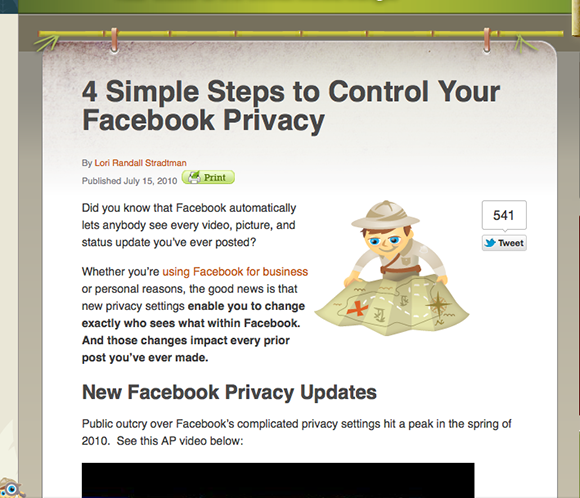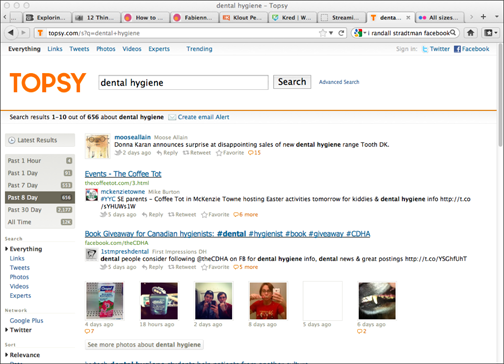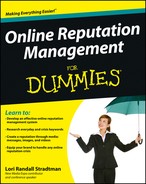Figure 10-1: Simple steps to control your Facebook privacy.
Balancing Meaning with Buzz
Organizations tend to release information to the Internet only when they want to say something specific — that is, when they have a message to broadcast. However, the Internet is a poor broadcast medium. It’s a community of voices or at least a two-way dialogue that’s open to others. Unless you can find a way to make your message attractive or “buzz-worthy,” you don’t have a hope of gaining traction with that message online.
When you strike a balance between infusing your content with meaning and making that content appealing enough to share, you become infinitely more trustworthy online. Many people, not realizing the impact of what they’re doing, are treating their online content like sales propaganda. In the realm of online ideas and reputation management, the more trustworthy you are, the more people will align themselves with you — they’ll sing your praises to friends, and come to your aid when your good name is slandered. You really do get what you give online, so give substantive content that’s framed in a meaningful context.
The only way you can stand out is to create something truly valuable for your audiences and do it in a way that’s charming, funny, expressive, powerful, or otherwise engaging in some way.
1. Define your brand’s voice.
2. Weave in your search engine optimization (SEO) keywords in a natural way.
3. Infuse your brand’s messaging with meaning.
4. Demonstrate value (results) for what you do or offer.
Using your voice
In Chapter 8, I begin by telling you why having a clear and inspiring brand voice is important and I show you how to cultivate your own. Be sure you use it and adapt it along the way as you discover how people are responding to you.
Oftentimes, what we think we’re delivering and what people are getting are different things. Try to put yourself in your audience’s shoes as you progress and pay attention to them. You may be surprised to discover how much more enthusiastically people respond to your message.
Once you’ve defined your brand’s unique voice, it’s essential for you to integrate that voice consistently, within both within your organization’s internal and external messaging, as follows:
![]() Internal messaging: This is the way you refer to things between departments. If you’re calling something “Project X,” it should be discussed as “Project X” via memos, departmental goals, and so on, so that your people can stay focused and rallied around what’s going on at present, instead of an old policy or way of doing things.
Internal messaging: This is the way you refer to things between departments. If you’re calling something “Project X,” it should be discussed as “Project X” via memos, departmental goals, and so on, so that your people can stay focused and rallied around what’s going on at present, instead of an old policy or way of doing things.
![]() External messaging: This is the way you refer to things (like “Project X”) online and via traditional media, such as in posts, updates, videos, press releases, and so on.
External messaging: This is the way you refer to things (like “Project X”) online and via traditional media, such as in posts, updates, videos, press releases, and so on.
Weaving in your SEO keywords
One way to balance meaningful content with buzz is to weave your SEO keywords into your message. (See Chapter 6 for more on how to research your keywords.) If you’ve researched well, you end up with a clear, heart-warming message that will attract lots of traffic.
Help people to find your great content by using your SEO keywords in post titles wherever possible. Don’t be shy about using one or two of your SEO keywords in each post, as long as you can do it unobtrusively. What I mean is that it should flow with the ideas and with the tone of voice you’re using. This needs to feel natural, so that it doesn’t look so obvious. It’s always better to focus on building relationships with people instead of search engines, but with a little practice you can do both.
Infusing meaning
Sometimes the best way to explain something is to give an example. Pretend for a moment that you own an air-conditioning/heating service, and you want to tailor your message in the context of keeping air clean for your family, one breath at a time. Instead of saying “take advantage of our annual, duct checkup special,” you can say something like “rest easy knowing the kids are breathing clean air with our annual, duct checkup special.”
From here you could go further. You could donate a percentage of sales to an organization that helps people who have asthma or other breathing difficulties. Contributing to your community in a real way creates a strong online reputation like nothing else. If you haven’t done this recently, brainstorm for what your core values are and how you can express them in a relevant way in your online content.
Giving something valuable
Build your strongest reputation possible online by contributing useful content to your audiences on the different social networks. These proven categories make your posts easy to understand, enjoy, and share:
![]() Tips: Give clear instructions with helpful screenshots.
Tips: Give clear instructions with helpful screenshots.
![]() Tricks: Show people how to do something faster, better, or more easily than the standard approach.
Tricks: Show people how to do something faster, better, or more easily than the standard approach.
![]() How-to’s: Show people how to do something with step-by-step instructions. Include pictures whenever possible. For example, right after Facebook made huge changes to its privacy policy, I wrote a post with simple instructions on how to navigate those new but complicated privacy settings. My post spread like wildfire, and it helped to establish my reputation as somebody who knows how to navigate social media networks reliably. (See Figure 10-1.)
How-to’s: Show people how to do something with step-by-step instructions. Include pictures whenever possible. For example, right after Facebook made huge changes to its privacy policy, I wrote a post with simple instructions on how to navigate those new but complicated privacy settings. My post spread like wildfire, and it helped to establish my reputation as somebody who knows how to navigate social media networks reliably. (See Figure 10-1.)

![]() Timely news: Be a reporter and break important news that matters to your audiences. If you’re a political blogger, be among the first to report new developments in the presidential election and opine about what it means. Facebook especially rates content on how much it’s trending at the moment. This gets you better coverage on Facebook’s “Top Stories” feed. Twitter and LinkedIn also value timely news with their respective “Trending Topics” and “Trending” areas. You share the exact story a week later and get little, if any traction on it. Remember, timely news updates are much more likely to spread your messages far and wide.
Timely news: Be a reporter and break important news that matters to your audiences. If you’re a political blogger, be among the first to report new developments in the presidential election and opine about what it means. Facebook especially rates content on how much it’s trending at the moment. This gets you better coverage on Facebook’s “Top Stories” feed. Twitter and LinkedIn also value timely news with their respective “Trending Topics” and “Trending” areas. You share the exact story a week later and get little, if any traction on it. Remember, timely news updates are much more likely to spread your messages far and wide.
![]() Relevant trends: Keeping in touch with trending topics helps your brand develop a reputation as being in touch. Organizations that can adapt more quickly while retaining their voices will build stronger reputations by virtue of having broader, more appreciative fan bases. Even if you aren’t in a fast moving industry, you can tap in to trends as a way of keeping your message current. For example, let’s say you’re a dentist, and you discover that people are starting to use baking soda–based toothpaste more often, you can post about this trend and explain how it relates to your audiences. Show them why it’s important. Figure 10-2 shows one way to quickly search for trends.
Relevant trends: Keeping in touch with trending topics helps your brand develop a reputation as being in touch. Organizations that can adapt more quickly while retaining their voices will build stronger reputations by virtue of having broader, more appreciative fan bases. Even if you aren’t in a fast moving industry, you can tap in to trends as a way of keeping your message current. For example, let’s say you’re a dentist, and you discover that people are starting to use baking soda–based toothpaste more often, you can post about this trend and explain how it relates to your audiences. Show them why it’s important. Figure 10-2 shows one way to quickly search for trends.
Figure 10-2: Using Topsy to search all dental hygiene trends.

![]() Numbered lists: An oldie but a goodie. Human nature loves a numbered list because you can correctly anticipate what you’re likely to get. There are entire blogs devoted to list posts, but I suggest you use them to spice up your content a few times a month. Variety is the spice of life, after all. Stay spicy.
Numbered lists: An oldie but a goodie. Human nature loves a numbered list because you can correctly anticipate what you’re likely to get. There are entire blogs devoted to list posts, but I suggest you use them to spice up your content a few times a month. Variety is the spice of life, after all. Stay spicy.
![]() Research: Depending on your areas of interest, you may find that you engage in some pretty interesting research. Particularly if you want to establish yourself as a thought leader in your industry, do quality research and share it online via posts, articles, white papers, and e-books. Most people do not charge for these resources, but they make them a free download with e-mail newsletter subscription. Having a robust e-mail list is always valuable to your online reputation management; I include a section on this in Chapter 12.
Research: Depending on your areas of interest, you may find that you engage in some pretty interesting research. Particularly if you want to establish yourself as a thought leader in your industry, do quality research and share it online via posts, articles, white papers, and e-books. Most people do not charge for these resources, but they make them a free download with e-mail newsletter subscription. Having a robust e-mail list is always valuable to your online reputation management; I include a section on this in Chapter 12.


